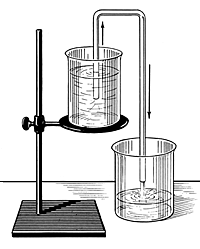siphon-, siphono- +
(Greek > Latin: tube, pipe, or hose; a tube or pipe from which water or fluid springs out)
2. The flowing back of used, contaminated, or polluted water from a plumbing fixture or vessel into the pipe which feeds it; caused by reduced pressure in the pipe.
Back siphonage is a result of liquids at a lower level drawing water from a higher level.
Back siphonage should not to be confused with backflow because back siphonage is a result of liquids at a lower level drawing water from a higher level; while backflow is pormoted entirely by pressure in the reservoir itself.
Backflow can't occur through an intermediate high-point while back siphonage flows through an intermediate high-point and so it is much more difficult to guard against.
The three main systems of flush toilets that work together are the bowl siphon, the flush mechanism, and the refill mechanism.
Inverted siphons are commonly called "traps" for their function in preventing smelly sewer gases from coming back out of drains and sometimes making solid objects; such as, rings recoverable after falling into a drain.

Siphons may be of any size. The action depends upon the influence of gravity (not, as sometimes stated, just on the difference in atmospheric pressure) and also upon the cohesive forces of atmospheric pressure.
In civil engineering, pipelines called inverted siphons are used to carry sewage or storm-water under streams, highway cuts, or other depressions in the ground.
In an inverted siphon, the liquid completely fills the pipe and flows under pressure, as opposed to the open-channel gravity flow that occurs in most sanitary or storm sewers.
3. A tube that is bent and used to move liquids from one container to another receptacle with gravity, as well as atmospheric pressure, moving the fluid in a siphon; for example, with the water in the longer downward arm (or leg) pulling the water up into the shorter arm (or leg).
Siphons draw fluid from a higher location to a lower one and are often used to remove liquid from containers; such as, gas tanks, fish aquaria, etc. which are difficult to empty with any other procedure.
4. A tube bent, often U-shaped, so that it has two roughly vertical and parallel legs of unequal length, used to transfer a liquid from a vessel placed at a higher level to another vessel at a lower level.
The tube is filled with the liquid; for example, by suction, and the shorter leg is immersed in the liquid to be transferred.
The longer leg is placed in or just above the lower vessel. The difference of the pressure in the shorter leg and at the lower end of the longer leg results in a continuous flow.
5. A tubular structure for intake or output of water in bivalves and other mollusks.
6. The sucking-type of proboscis (long flexible snout or nose) in many arthropods.
"Incorrectly defined" by the Oxford English Dictionary and others for over 99 years?
- Siphons don't work, it turns out, because of atmospheric pressure, as the OED or Oxford English Dictionary has been saying since 1911: "A pipe or tube of glass, metal or other material, bent so that one leg is longer than the other, and used for drawing off liquids by means of atmospheric pressure, which forces the liquid up the shorter leg and over the bend in the pipe."
- Dr. Stephen Hughes, from the University of Technology in Brisbane, noticed what he considered to be an error in the dictionary during research for an article for science teachers.
- Dr Hughes said he was stunned when he realized that the dictionary had the definition wrong.
- "It is gravity that moves the fluid in a siphon, with the water in the longer downward arm pulling the water up the shorter arm," Dr. Hughes said.
- "We would all have an issue if the dictionary defined a koala as a species of bear, or a rose as a tulip," he said.
- "I found that almost every dictionary contained the same misconception that atmospheric pressure, not gravity, pushed liquid through the tube of a siphon."
- An OED spokesman said the definition was written in 1911 by "editors who were not scientists" and that Dr. Hughes' notes would be taken into account when the entry was rewritten.
- Hughes said he discovered the error when he visited a huge siphon that transfers enormous amounts of water from a river system to a depleted lake in South Australia.
- Hoping to use the project as part of an education paper, he researched the word and found "that almost every dictionary contained the same misconception" about atmospheric pressure being what pushed liquids through a siphon; however, there are those who say Dr. Hughes is also wrong to say that only gravity is involved.
- Doesn't it make sense that gravity pulls liquid in the lower leg down, creating a lower pressure in the top of the siphon which allows atmospheric pressure to push water up into the upper leg?
2. A barometer having a tube bent like a hook with the longer leg closed at the top.
The height of the mercury in the longer leg shows the pressure of the atmosphere (and gravity?).
2. A bottle for aerated water, fitted with a bent tube through the neck, the water being forced out, when a valve is opened, by the pressure on its surface of the gas accumulating within the bottle.
2. A double-leg liquid-column gauge used to measure the difference between two fluid pressures.
As a result the water begins to flow out and does not stop until it falls below the siphon inlet.
A cross reference of word units that are related, directly and/or indirectly, with "tube, pipe": aulo-; can-, cann-; duc-, -duct (to lead, leading); fistul-; syringo-; tub-.

